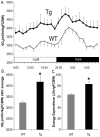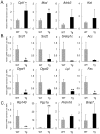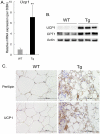Perilipin overexpression in white adipose tissue induces a brown fat-like phenotype
- PMID: 21103377
- PMCID: PMC2982838
- DOI: 10.1371/journal.pone.0014006
Perilipin overexpression in white adipose tissue induces a brown fat-like phenotype
Erratum in
- PLoS One. 2010;5(11). doi: 10.1371/annotation/45438cdc-913a-4009-b2c1-5c1bc437c926
Abstract
Background: Perilipin A (PeriA) exclusively locates on adipocyte lipid droplets and is essential for lipid storage and lipolysis. Previously, we reported that adipocyte specific overexpression of PeriA caused resistance to diet-induced obesity and resulted in improved insulin sensitivity. In order to better understand the biological basis for this observed phenotype, we performed additional studies in this transgenic mouse model.
Methodology and principal findings: When compared to control animals, whole body energy expenditure was increased in the transgenic mice. Subsequently, we performed DNA microarray analysis and real-time PCR on white adipose tissue. Consistent with the metabolic chamber data, we observed increased expression of genes associated with fatty acid β-oxidation and heat production, and a decrease in the genes associated with lipid synthesis. Gene expression of Pgc1a, a regulator of fatty acid oxidation and Ucp1, a brown adipocyte specific protein, was increased in the white adipose tissue of the transgenic mice. This observation was subsequently verified by both Western blotting and histological examination. Expression of RIP140, a regulator of white adipocyte differentiation, and the lipid droplet protein FSP27 was decreased in the transgenic mice. Importantly, FSP27 has been shown to control gene expression of these crucial metabolic regulators. Overexpression of PeriA in 3T3-L1 adipocytes also reduced FSP27 expression and diminished lipid droplet size.
Conclusions: These findings demonstrate that overexpression of PeriA in white adipocytes reduces lipid droplet size by decreasing FSP27 expression and thereby inducing a brown adipose tissue-like phenotype. Our data suggest that modulation of lipid droplet proteins in white adipocytes is a potential therapeutic strategy for the treatment of obesity and its related disorders.
Conflict of interest statement
Figures






Similar articles
-
EID1-induces brown-like adipocyte traits in white 3T3-L1 pre-adipocytes.Biochem Biophys Res Commun. 2010 Jul 23;398(2):160-5. doi: 10.1016/j.bbrc.2010.06.034. Epub 2010 Jun 10. Biochem Biophys Res Commun. 2010. PMID: 20541531
-
TFE3 controls lipid metabolism in adipose tissue of male mice by suppressing lipolysis and thermogenesis.Endocrinology. 2013 Oct;154(10):3577-88. doi: 10.1210/en.2013-1203. Epub 2013 Jul 24. Endocrinology. 2013. PMID: 23885019
-
BMP4-mediated brown fat-like changes in white adipose tissue alter glucose and energy homeostasis.Proc Natl Acad Sci U S A. 2013 Feb 26;110(9):E798-807. doi: 10.1073/pnas.1215236110. Epub 2013 Feb 6. Proc Natl Acad Sci U S A. 2013. PMID: 23388637 Free PMC article.
-
CIDE Family-Mediated Unique Lipid Droplet Morphology in White Adipose Tissue and Brown Adipose Tissue Determines the Adipocyte Energy Metabolism.J Atheroscler Thromb. 2017 Oct 1;24(10):989-998. doi: 10.5551/jat.RV17011. Epub 2017 Sep 5. J Atheroscler Thromb. 2017. PMID: 28883211 Free PMC article. Review.
-
Is the heat surrounding adipose tissue mitochondria warranted?Curr Opin Clin Nutr Metab Care. 2014 Nov;17(6):503-8. doi: 10.1097/MCO.0000000000000102. Curr Opin Clin Nutr Metab Care. 2014. PMID: 25102333 Free PMC article. Review.
Cited by
-
Impact of Maternal Melatonin Suppression on Amount and Functionality of Brown Adipose Tissue (BAT) in the Newborn Sheep.Front Endocrinol (Lausanne). 2015 Jan 6;5:232. doi: 10.3389/fendo.2014.00232. eCollection 2014. Front Endocrinol (Lausanne). 2015. PMID: 25610428 Free PMC article.
-
Perilipin 3 Deficiency Stimulates Thermogenic Beige Adipocytes Through PPARα Activation.Diabetes. 2018 May;67(5):791-804. doi: 10.2337/db17-0983. Epub 2018 Feb 13. Diabetes. 2018. PMID: 29440067 Free PMC article.
-
Soluble Epoxide Hydrolase Inhibition by t-TUCB Promotes Brown Adipogenesis and Reduces Serum Triglycerides in Diet-Induced Obesity.Int J Mol Sci. 2020 Sep 24;21(19):7039. doi: 10.3390/ijms21197039. Int J Mol Sci. 2020. PMID: 32987880 Free PMC article.
-
An in vivo reporter for tracking lipid droplet dynamics in transparent zebrafish.Elife. 2021 Jun 11;10:e64744. doi: 10.7554/eLife.64744. Elife. 2021. PMID: 34114952 Free PMC article.
-
Involvement of a battery of investigated genes in lipid droplet pathophysiology and associated comorbidities.Adipocyte. 2024 Dec;13(1):2403380. doi: 10.1080/21623945.2024.2403380. Epub 2024 Sep 27. Adipocyte. 2024. PMID: 39329369 Free PMC article. Review.
References
-
- Kahn R, Buse J, Ferrannini E, Stern M American Diabetes Association; European Association for the Study of Diabetes. The metabolic syndrome: time for a critical appraisal: joint statement from the American Diabetes Association and the European Association for the Study of Diabetes. Diabetes Care. 2005;28:2289–2304. - PubMed
-
- DeFronzo RA. Dysfunctional fat cells, lipotoxicity and type 2 diabetes. Int J Clin Pract Suppl. 2004;143:9–21. - PubMed
-
- Greenberg AS, Egan JJ, Wek SA, Garty NB, Blanchette-Mackie EJ, et al. Perilipin, a major hormonally regulated adipocyte-specific phosphoprotein associated with the periphery of lipid storage droplets. J Biol Chem. 1991;266:11341–11346. - PubMed
-
- Brasaemale DL. The perilipin family of structural lipid droplet proteins: stabilization of lipid droplets and control of lipolysis. J Lipid Res. 2007;48:2547–2559. - PubMed
Publication types
MeSH terms
Substances
Associated data
- Actions
Grants and funding
LinkOut - more resources
Full Text Sources
Other Literature Sources
Molecular Biology Databases

